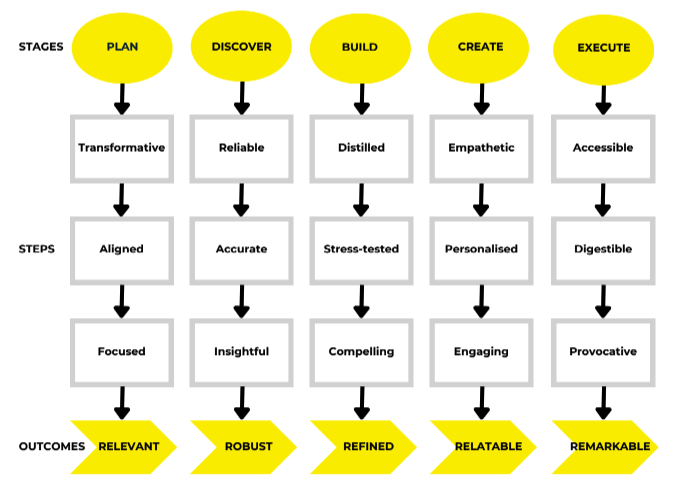This edited extract is from Data Storytelling in Marketing by Caroline Florence ©2024 and is reproduced and adapted with permission from Kogan Page Ltd.
Part One of this book outlined the need for data storytelling, the benefits of data storytelling for the marketing function, and the practical barriers that can get in the way of creating a great data story.
Part Two answers the question: ‘What do I need to do to create a great data story in practice?
The 5R2 roadmap has five key stages with expected outcomes, each supported by three practical steps.
 Screenshot from datastorytellinginmarketing.com/toolkit, June 2024
Screenshot from datastorytellinginmarketing.com/toolkit, June 2024Make It RELEVANT
A relevant data story must focus on the audience’s knowledge levels, needs and preferences and should include:
- A clear premise that will generate a transformation in the hearts and minds of the audience.
- A clear understanding of the context aligned to the audience’s needs.
- A focused story that answers the killer question for the audience.
A relevant story requires strategic thinking skills to outline the story plan.
There are several benefits to this stage, including:
- The opportunity to gain early input, collaboration and co-creation to feed into your story development.
- A clear sense of purpose to keep your story development on track.
- A chance to get nearer to right first time, thus saving significant iteration time at the later stages of your story development.
Make It ROBUST
A robust data story must stand up to scrutiny and should include:
- A solid interpretation drawn from a range of reliable data sources.
- A data-driven argument and recommendation based on accurate and up to date information.
- An insightful point of view providing the audience with a ‘So what?’ and ‘Now what?’
A robust story requires strong analysis skills to surface and discover the key insights.
There are several benefits to this stage, including:
- The opportunity to uncover new insights and ideas, rather than predictable findings.
- A chance to draw out richer, nuanced insights that can give depth to your data story.
- A sense of confidence in the credibility of your interpretation and recommendations.
Make It REFINED
A refined data story must provide a clear and compelling narrative and should include:
- A story resolution that is synthesized and distilled into a key message.
- A stress-tested story resolution that can drive real decisions and actions.
- A compelling structure that makes it easy to follow the argument.
A refined story requires critical thinking skills to build a data story that is easy to follow and engage with.
There are several benefits to this stage, including:
- The chance to pinpoint the specific ask the data story needs to get across to the audience.
- A sense of confidence that your data story offers the audience solutions that are both commercially viable and practically feasible.
- The opportunity to focus your audience on decisions needed or actions required, rather than all of their energy being used to understand the insights.
Make It RELATABLE
A relatable data story needs to enrich the insight message with an emotional connection and should include:
- An empathetic understanding of the humans involved in the data story.
- A personalized approach that speaks to the specific target audiences’ hearts and minds.
- An engaging story flow that draws the audience in.
A relatable story requires emotional intelligence to create a story grounded in real life and enriched by human experience.
There are several benefits to this stage, including:
- The increased likelihood of cutting through and resonating with the audience.
- The chance to influence real results and meaningful outcomes.
- A sense of confidence in your ability to integrate data, logic and emotion in your data storytelling.
Make It REMARKABLE
A remarkable data story must cut through the noise, land the message and provide a catalyst for action and should include:
- An easy-to-follow and accessible data story presentation.
- A range of digestible micro-content that appeals to a wide range of audience needs.
- A storytelling delivery that is provocative and stimulates reflection and debate.
A remarkable story requires creative thinking and flair to execute a story that will stand out from the crowd and drive action.
There are several benefits to this stage, including:
- The ability to keep a distracted audience’s attention.
- The opportunity to drive further interest in your data story.
- The chance to disrupt the status quo and move beyond default thinking.
To read the full book, SEJ readers have an exclusive 25% discount code and free shipping to the US and UK. Use promo code SEJ25 at koganpage.com here.
More resources:
Featured Image: Visual Generation/Shutterstock
 seolounge
seolounge